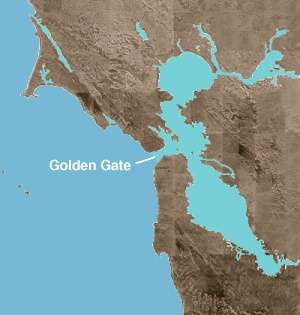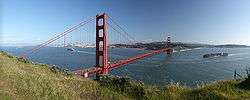Golden Gate

The Golden Gate is the North American strait that connects San Francisco Bay to the Pacific Ocean. It is defined by the headlands of the San Francisco Peninsula and the Marin Peninsula, and, since 1937, has been spanned by the Golden Gate Bridge.
Geology
During the last Ice Age, when sea level was several hundred feet lower, the waters of the glacier-fed Sacramento River and the San Joaquin River scoured a deep channel through the bedrock on their way to the ocean.[1] The strait is well known today for its depth and powerful tidal currents from the Pacific Ocean. Many small whirlpools and eddies can form in its waters. With its strong currents, rocky reefs and fog, the Golden Gate is the site of over 100 shipwrecks.
Climate

The Golden Gate is often shrouded in fog, especially during the summer. Heat generated in the California Central Valley causes air there to rise, creating a low pressure area that pulls in cool, moist air from over the Pacific Ocean. The Golden Gate forms the largest break in the hills of the California Coast Range, allowing a persistent, dense stream of fog to enter the bay there.[2]
History

Before the Europeans arrived in the 18th century, the area around the strait and the bay was inhabited by the Ohlone to the south and Coast Miwok people to the north. Descendants of both tribes remain in the area.

The strait was surprisingly elusive for early European explorers, presumably due to this persistent summer fog. The strait is not recorded in the voyages of Juan Rodriguez Cabrillo nor Francis Drake, both of whom may have explored the nearby coast in the 16th century in search of the fabled Northwest Passage. The strait is also unrecorded in observations by Spanish galleons returning from the Philippines that laid up in nearby Drakes Bay to the north. These galleons rarely passed east of the Farallon Islands (27 miles west of the Golden Gate), fearing the possibility of rocks between the islands and the mainland.
The first recorded observation of the strait occurred nearly two hundred years later than the earliest European explorations of the coast. In 1769, Sgt. José Francisco Ortega, the leader of a scouting party sent north along the San Francisco Peninsula by Don Gaspar de Portolá from their expedition encampment in San Pedro Valley to locate the Point Reyes headlands, reported back to Portolá that he could reach the location because of his encounter with the strait.[3] On 5 August 1775 Juan de Ayala and the crew of his ship San Carlos became the first Europeans known to have passed through the strait, anchoring in a cove behind Angel Island, now named in Ayala's honour. Until the 1840s, the strait was called the "Boca del Puerto de San Francisco" ("Mouth of the Port of San Francisco"). On 1 July 1846, before the discovery of gold in California, the entrance acquired a new name. In his memoirs, John C. Frémont wrote, "To this Gate I gave the name of "Chrysopylae", or "Golden Gate"; for the same reasons that the harbor of Byzantium was called Chrysoceras, or Golden Horn."[4]
Coordinates: 37°49′N 122°29′W / 37.817°N 122.483°W

1920s
In the 1920s, no bridge spanned the watery expanse between San Francisco and Marin in California—so when the U.S. Post Office issued a postage stamp on 1 May 1923, celebrating The Golden Gate, the issue naturally portrayed the scene without a bridge.[5] The schooner sailing ship in the engraving is the USS Babcock, which served in the United States Navy from 1917 to 1919, and is seen passing through the Golden Gate into San Francisco Bay, its port of call.[6]
Golden Gate Bridge

The Golden Gate Bridge is a suspension bridge spanning the Golden Gate, the opening of the San Francisco Bay onto the Pacific Ocean. As part of both US Highway 101 and California Route 1, it connects the city of San Francisco on the northern tip of the San Francisco Peninsula to Marin County.
The Golden Gate Bridge was the longest suspension bridge span in the world when completed in 1937, and is an internationally recognized symbol of San Francisco and California. Since its completion, the span length has been surpassed by eight other bridges. It still has the second longest suspension bridge main span in the United States, after the Verrazano-Narrows Bridge in New York City. In 2007, it was ranked fifth on the List of America's Favorite Architecture by the American Institute of Architects.
In local culture
The name "Golden Gate" holds an important connotation in the Bay Area as a reference point for the region, and is attached to the bridge that spans the strait, a large park in San Francisco, and various local establishments.

Golden Gate Park
Golden Gate Park, located in San Francisco, California, is a large urban park consisting of 1017 acres (4.1 km², 1.6 mi²) of public grounds. Configured as a rectangle, it is similar in shape but 174 acres (0.7 km², 0.27 mi²) larger than Central Park in New York, to which it is often compared. With 13 million visitors annually, Golden Gate is the fifth most visited city park in The United States after Central Park in New York City, Lincoln Park in Chicago, and Balboa Park and Mission Bay Park in San Diego.[7] It is not adjacent to the Golden Gate strait.
References
- ↑ A similar process created the undersea Hudson Canyon off the coast of New York and New Jersey.
- ↑ James William Steele (1888). Rand, McNally & Co.'s New Overland Guide to the Pacific Coast: California, Arizona, New Mexico, Colorado, and Kansas. Rand, McNally. p. 175.
- ↑ Eldredge, Zoeth S. The beginnings of San Francisco. San Francisco: Zoeth S. Eldredge, 1912, 31-32.
- ↑ Gudde, Erwin G. California Place Names (2004) University of California Press, London, England. ISBN 0-520-24217-3.
- ↑ Scotts US Stamp Catalogue
- ↑ Smithsonium National Postal Museum
- ↑ http://cityparksurvey.tpl.org/reports/report_display.asp?rid=27
External links
| Wikimedia Commons has media related to Golden Gate. |
- National Park Service: Discovery of the Golden Gate
- Golden Gate 360 Image (QTVR)
- Golden Gate 360 Image (Java)
- Digitally Restored Panoramic Composited View of The Golden Gate, Fort Point, and San Francisco Bay as seen from "Land's End" near Sutro Heights, c. 1895.
| |||||||||||||||||||||||||||||||||||||||||
